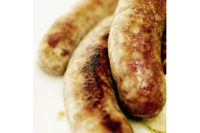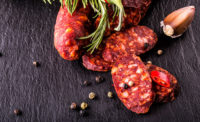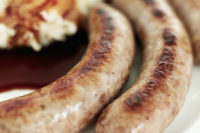Sausage may not have bacon’s cult appeal, but it has proven surprisingly resilient to shifting consumer taste and health preferences, and the size of their wallets.
After a slight slowdown in sales in 2012 and 2013, perhaps due to a focus on healthy eating after the recession eased, retail sales of the $8.7 billion hot dog and sausage category grew 4.5 percent in 2014 — and 18 percent overall between 2009 to 2014, reported Mintel’s “Hot Dogs and Sausages” September 2014 report.
Sausage ingredient mentions at restaurants fell 4.6 percent from the fourth quarter of 2013 to the fourth quarter of 2014, says Lizzy Freier, editor, Menu Analysis, at Technomic Inc., a Chicago-based consulting and research firm.
However, “this number is not too significant because there was a large base to begin with — 5,263 items in 2014 at Top 500 chains, emerging chains, high-volume independents, regional chains and regional independents,” says Freier.
What's on the MenuSausage still rules breakfast. According to Datassential’s Sausage Menuing Report, sausage is on 74.4 percent of breakfast menus, while it appears on 47.4 percent of all-day menus, 30.3 percent of dinner menus and 21 percent of lunch menus. “The gains in sausage menuing appear to be driven by non-breakfast menuing, rather than breakfast menuing, at which sausage is a traditional ingredient,” says Maeve Webster, senior director at Datassential, a Chicago-based menu trends and food market research firm, as all of the other segments increased while breakfast menuing decreased. Sausage popularity has remained consistent across regions, as well. The Midwest has the most mentions of sausage on menus at 63.6 percent, with the Northeast following at 58.6 percent, then the West at 57.8 percent and the South at 55 percent. “There have been little to no changes in regional menuing of sausages, with the exception of the Midwest in which penetration has grown by just over 4 percent,” Webster says. Sausage penetration on menus has changed very little over the past four years, although there have been gains in the midscale and casual dining segments, she says. Sausage was on 1.8 percent more midscale menus (up to 61.4 percent from 60.3 percent) and 4.5 percent more casual menus (63.3 percent from 60.6 percent) in 2014, compared with 2010. Quick Service Restaurants (QSR) and fine-dining menus were down, however, 3.9 percent and 0.2 percent respectively. “Among QSR operators, sausages have lost some ground despite the strength of the breakfast daypart,” Webster says. When consumers order sausage, they prefer it in entrees (56.3 percent), as a side (28.7 percent) and in appetizers (13.8 percent). “While penetration of sausage is highest for entrée applications, the share of operators featuring sausage in appetizers has increased by nearly 17 percent since 2010,” says Webster. Since 2010, chains have increased sausage menuing (4.5 percent) more so than any other segment of operators such as regionals and independents. “Independents, however, are now menuing sausage slightly more often than in 2010,” an increase of 1.1 percent, says Webster. “For sausage to remain relevant and gain new interest, innovation at the independents’ level is necessary.” |
Dinner sausage dollar sales at retail, in fact, increased 9.8 percent to $3.3 billion, and unit sales increased 2.9 percent to 850.5 million pounds, according to Chicago-based IRI Group (as of December 28, 2014). Breakfast sausage and ham dollar sales increased 9.7 percent to $1.7 billion, but unit sales decreased 2.3 percent to 461.5 million pounds, as well.
U.S. retail sales of refrigerated dinner sausage alone grew 8 percent between 2012 and 2014, according to data provided by The Hillshire Brands Company.
This growth is only expected to continue for the next five years, at least. The packaged, refrigerated dinner sausages segment is predicted to grow about 17 percent between 2014 and 2019, to reach $4.1 billion in 2019, says Mintel.
The reason? Sausage manufacturers are offering more natural products, fresh presentations and ethnic and innovative flavors to encourage consumers to return to the category, says Mintel.
“We’re seeing terrific growth in both the hot dog and sausage category,” says Alicia Mosley, director of marketing for Aidells. “Both healthier/naturally positioned options, as well as evolving consumer tastes for more authentic/ethnic/adventurous flavor profiles, is driving category growth.”
A healthier sausage
In 2014, the most popular claims on sausage products were “microwaveable” (53 percent), “low/no/reduced allergen” (44 percent), “no additives or preservatives” (43 percent) and “gluten free” (42 percent), Mosley says.
Consumers are wary of processed foods today, which may have resulted in a dip in sales for sausage and hot dogs, Mintel notes. Accordingly, to reach health-conscious consumers, products are positioned today as being more natural, with cleaner labels and of better quality.
“Poultry options as well as no added nitrites/nitrates are hitting on the ‘healthier’ positioning, and our flavor profiles hit on what we like to call the ‘flavor adventure’ preferences of our consumers who are looking for fresh, unique and adventurous flavors within their dinner sausage,” Matheu says.
Last year, the Hillshire Farm brand, for instance, launched Hillshire Farm American Craft sausages, which have a cleaner label profile with “no added nitrates/nitrites” and hit on a strong consumer interest in better-for-you options.
“In fact, 58 percent of sausage and hot dog eaters report having purchased hot dogs or sausages without nitrates or nitrites in the past 12 months,” says Lindsay Brady, director of marketing for Hillshire Farm brand. “Not only do these products offer the absence of no added nitrites or nitrates, we have offered a flavorful taste profile within the line.”
The nitrate- or nitrite-free line includes flavors such as American Craft Jalapeño & Cheddar, Smoky Bourbon, Garlic & Onion and Original Bratwurst.
Chicken sausage has also been offered for quite some time as a healthier alternative to regular sausage products. Aidells, for one, offers an all-natural chicken sausage with a unique flavor and variety of flavor combinations.
“This is the best of both worlds — hitting on flavor and better-for-you needs given the chicken sausage profile,” says Mosley. “Additionally, these products are gluten free, with no nitrites or artificial ingredients and no added hormones.”
These products also come in organic and no-antibiotics-used varieties at select retailers.
Presentation matters. To continue appealing to consumers seeking fresh, flavorful ingredients, Aidells’ products contain visible chunks of real fruit, vegetables, herbs and cheeses, says Mosley. Such offerings include Aidells’ Chicken & Apple Dinner Sausage, Spicy Mango with Jalapeno, Pineapple & Bacon and Portobello & Swiss Cheese.
Stronger taste
“Our brands are taking the dinner sausage ‘beyond the bun’ with unique flavor options that are easily integrated into familiar go-to recipes,” says Matheu.
Consumers are certainly seeking distinctive flavors, with 67 percent saying they buy sausages or hot dogs with unique flavors, according to Mintel’s report.
Not surprisingly, the most important reason given by consumers who buy hot dogs or sausages is they like their taste (57 percent), followed by convenient prep (54 percent) and affordability (31 percent), Mintel shows.
Millennials are more likely to buy hot dogs and sausages than other generations, says Mintel. They are looking for freshly positioned items, because they are health conscious and concerned about ingredients. Consequently, they are also the generation most likely to order sausage from the meat counter, including dinner sausage (57 percent), breakfast sausage (54 percent) and hot dogs (55 percent), says Mintel. They also look for sausage that is made with poultry, locally sourced products and unique or gourmet flavors.
Children are the other big consumers of hot dogs and sausages, as 85 percent of households with one or more children report eating frankfurters or hot dogs compared with 77 percent of households without children, reports Mintel. As the number of households with kids declines (down 2.5 percent between 2003 and 2013), purchases of foods popular with children have also declined.
In the future, Hispanic households will play a bigger role in the market as they have a high sausage consumption rate (77 percent) and are growing. They prefer more natural offerings and ethnic presentations, says Mintel.
On the menu
Despite sausage’s slight decrease in menu listings, it continues to remain strong in foodservice because of its general appeal at breakfast and on pizzas, says Freier.
“Sausage will always be a staple side for egg dishes and on breakfast sandwiches and will always be a favorite topping for pizzas,” says Freier. “The reason for its slight drop may be because operators and/or customers are substituting traditional sausage for healthier alternatives, such as turkey on breakfast sandwiches or vegetables on pizzas.”
Turkey sausage in particular is growing on menus (3.6 percent year-over-year).
“Dunkin’ Donuts recently made its Turkey Sausage Flatbread and Wake-up Wrap available permanently, for example, and Potbelly Sandwich Shop launched a Lentil, Kale & Turkey Sausage Soup,” says Freier.
She says Technomic also saw multiple mentions of chorizo sausage, as consumers starting demanding both spicier foods and more ethnic foods.
“Denny’s South by Southwest Skillet that rolled out recently features crumbled chorizo sausage, sautéed mushrooms, fire-roasted bell peppers and onions, seasoned red-skinned potatoes, grilled seasoned chicken breast, shredded cheddar and pepper jack queso,” says Freier.
In addition, an interesting uptick in sausage mentions occurred in the burger category over the last year (33.3 percent).
“Buffalo Wings & Rings’ Chorizo Nacho Burger, for example, features spicy chorizo sausage with a creamy queso sauce, crunchy tortilla strips, tomato, jalapeño and a touch of cilantro,” Freier says.
Meat-on-meat mentions, such as pairing sausage with another protein in a dish, were also up.
“Chuck E. Cheese’s Cali Alfredo Pizza, for example, combines chicken breast and sausage along with other ingredients,” says Freier. “ZPizza’s Carnivore Pizza combines pepperoni, fennel sausage, smoked ham, bacon and oregano.”
And sausage can only be expected to keep showing up in typical dishes, such as omelets, breakfast sandwiches, pizzas and pastas, notes Freier.











